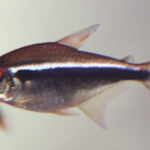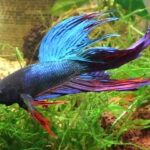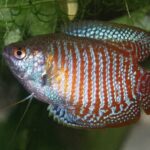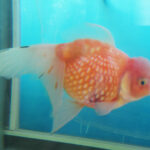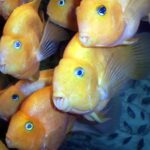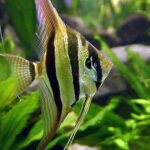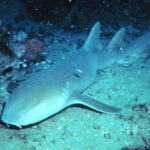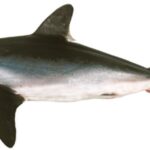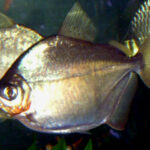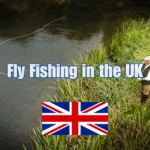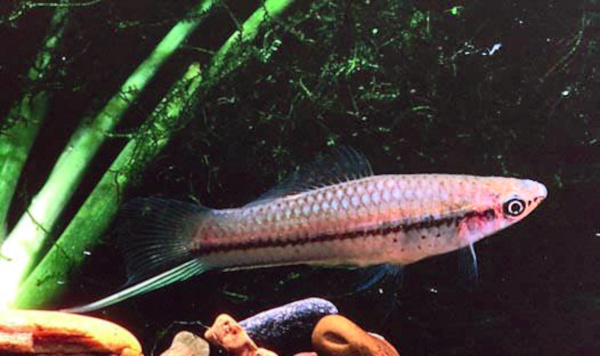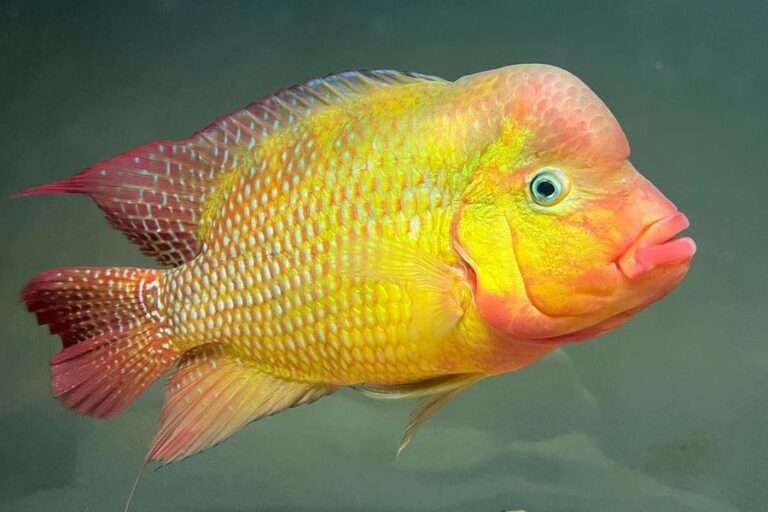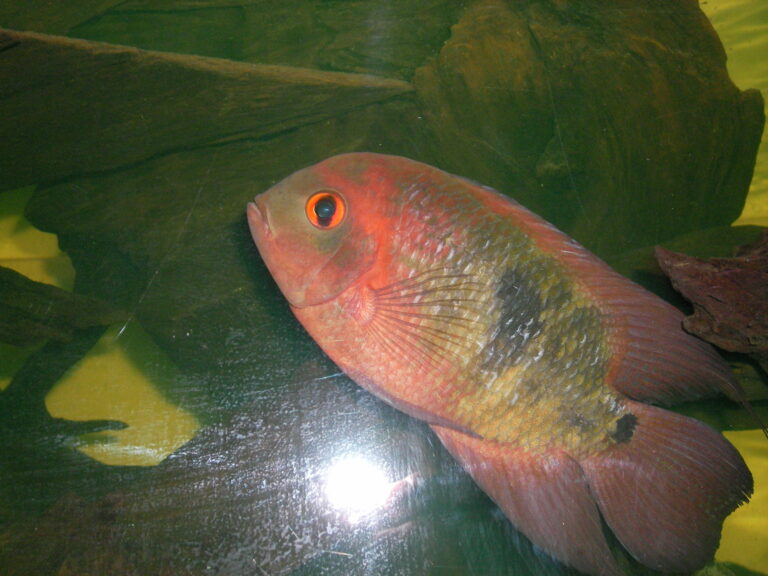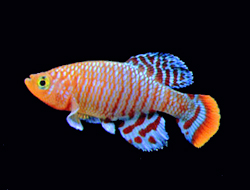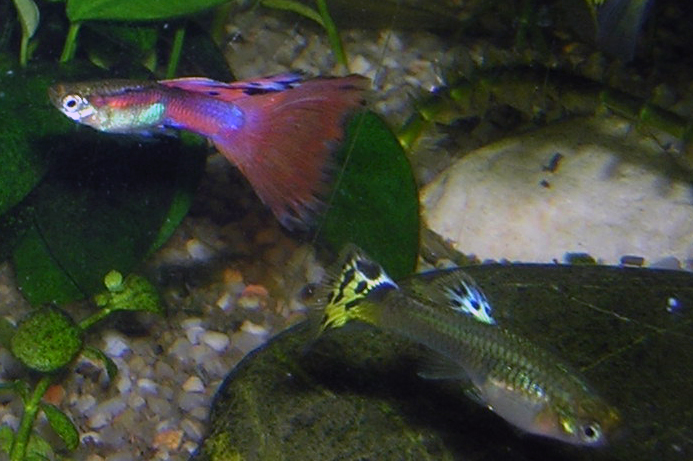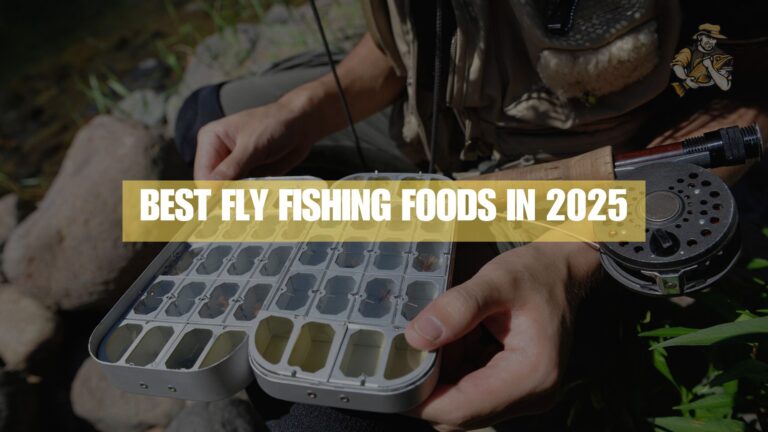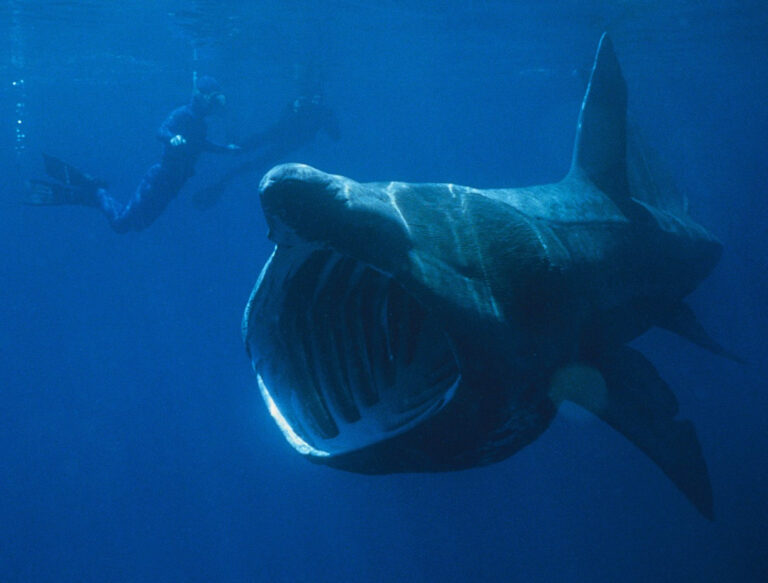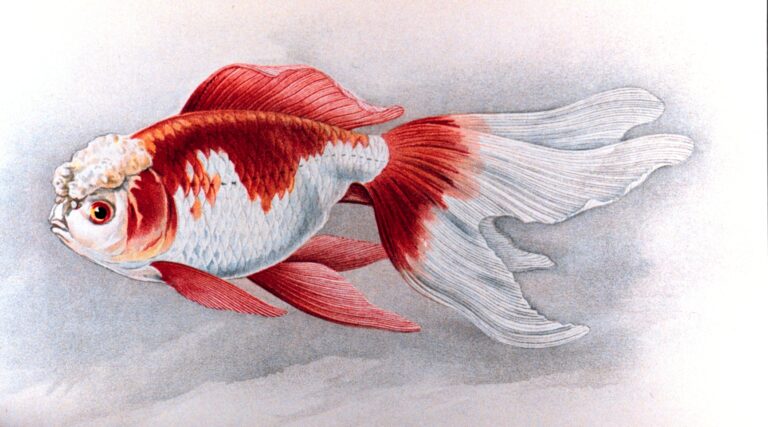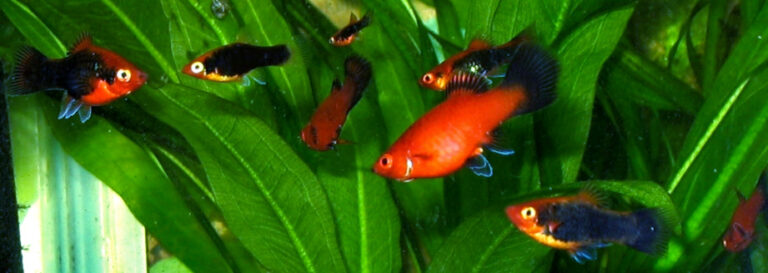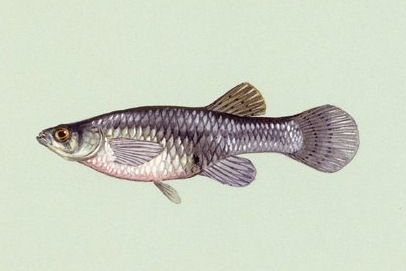Yellow Lab Cichlid
By Ryan Maron | Last Modified: June 8, 2025
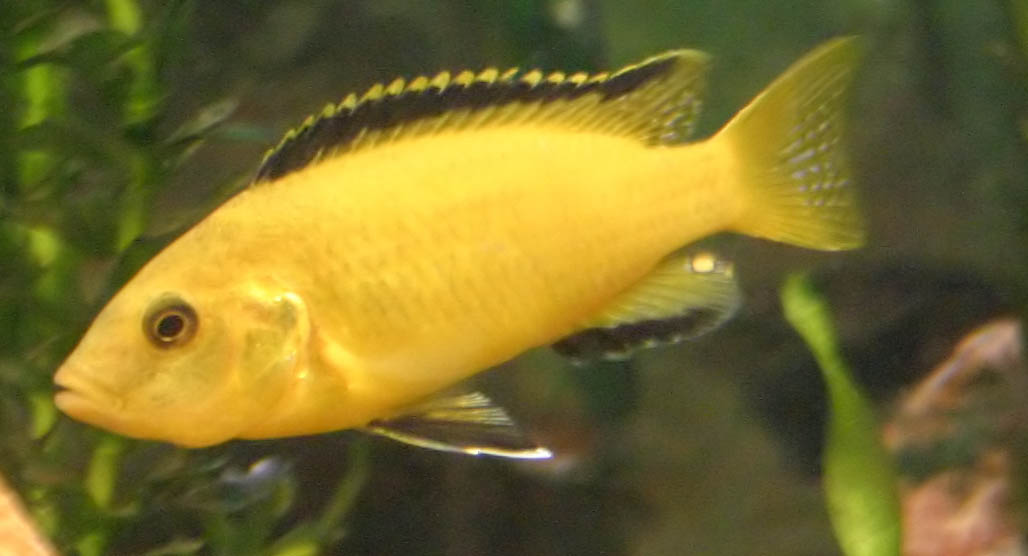
The Yellow Lab Cichlid (*Labidochromis caeruleus*) stands as one of Africa’s most recognizable freshwater fish species, distinguished by its vibrant golden-yellow coloration and peaceful temperament among cichlids. Native to the rocky shores of Lake Malawi in East Africa, this species has evolved into a cornerstone of both its natural ecosystem and the global aquarium trade. The Yellow Lab Cichlid plays a crucial ecological role as an algae grazer and small invertebrate predator, helping maintain the delicate balance of Lake Malawi’s complex food web. Its adaptive feeding strategies and territorial behaviors make it an essential component of the lake’s rocky habitat zones, where it competes with dozens of other endemic cichlid species for food and breeding territories.
| Feature | Details |
| Common Name | Yellow Lab Cichlid |
| Scientific Name | Labidochromis caeruleus |
| Family | Cichlidae |
| Typical Size | 10-12 cm (4-5 inches), 15-25 grams |
| Habitat | Rocky shorelines and intermediate depths |
| Diet | Algae, small invertebrates, zooplankton |
| Distribution | Endemic to Lake Malawi, East Africa |
| Conservation Status | Least Concern |
Taxonomy & Classification
The Yellow Lab Cichlid belongs to the family Cichlidae, one of the most diverse fish families in the world with over 2,000 described species. Within this family, *Labidochromis caeruleus* represents the type species of the genus *Labidochromis*, which contains approximately 18 recognized species endemic to Lake Malawi. The genus name derives from the Greek words “labis” (forceps) and “chromis” (a type of fish), referencing the distinctive dental structure that characterizes these cichlids.
Taxonomically, the Yellow Lab Cichlid falls within the subfamily Pseudocrenilabrinae, commonly known as African cichlids. This classification places it among the mbuna group, a collection of rock-dwelling cichlids that have undergone extensive adaptive radiation within Lake Malawi’s rocky habitats. The species was first scientifically described by Fryer in 1956, though local fishing communities had recognized and utilized this species for centuries before formal scientific classification.
The phylogenetic relationships within *Labidochromis* continue to evolve as genetic analysis reveals cryptic species and population variations across different regions of Lake Malawi. Recent molecular studies suggest that what was once considered a single widespread species may actually represent a species complex with distinct evolutionary lineages adapted to specific geographic locations within the lake.
Physical Description
The Yellow Lab Cichlid exhibits remarkable sexual dimorphism in both coloration and size, with males typically displaying more intense yellow pigmentation and reaching larger adult sizes than females. Adult males achieve lengths of 10-12 centimeters, while females generally remain smaller at 8-10 centimeters. The species’ characteristic bright yellow coloration results from specialized chromatophores containing yellow pigments, primarily xanthophores and erythrophores.
The body shape reflects typical mbuna characteristics: laterally compressed, moderately elongated, and built for maneuvering through rocky crevices. The dorsal fin extends along most of the back, featuring 18-19 spines followed by 8-9 soft rays. Males develop elongated dorsal and anal fins with age, often displaying subtle blue or black edging along the fin margins. The anal fin contains distinctive egg spots (ocelli) in males, which play a crucial role during breeding displays and mouthbrooding behavior.
The head structure reveals specialized adaptations for the species’ feeding ecology. The mouth is relatively small and terminal, equipped with fine, closely-set teeth adapted for scraping algae and picking small invertebrates from rock surfaces. The pharyngeal teeth, located deeper in the throat, are designed for processing algal material and small prey items. The eye is proportionally large, reflecting the species’ need for precise visual coordination when foraging in complex rocky environments.
Juvenile Yellow Lab Cichlids display more subdued coloration, often appearing pale yellow or even silvery-white with faint vertical bars. This cryptic juvenile coloration provides protection from predators during the vulnerable early life stages. As individuals mature, the characteristic bright yellow develops gradually, with full adult coloration typically appearing around 6-8 months of age.
Habitat & Distribution
*Labidochromis caeruleus* maintains an endemic distribution within Lake Malawi, the ninth-largest lake in the world and the third-largest in Africa. The species primarily inhabits the rocky shoreline zones, known locally as “mbuna habitats,” along the northwestern and central regions of the lake. These areas are characterized by extensive boulder fields, rocky outcrops, and cave systems that provide both feeding opportunities and shelter from predators.
The preferred depth range extends from shallow water areas of 1-2 meters down to approximately 20 meters, though most populations concentrate between 3-15 meters depth. This depth preference corresponds to optimal light penetration for algal growth on rock surfaces, which forms a significant portion of the species’ diet. Water temperature in these habitats remains relatively stable year-round, ranging from 24-28°C, while pH levels typically measure between 7.8-8.6, reflecting the lake’s alkaline chemistry.
The rocky habitat structure creates a complex three-dimensional environment with numerous territorial boundaries and microhabitats. Individual Yellow Lab Cichlids often establish territories around specific rock formations, defending prime algae-growing surfaces from competitors. These territories can range from 0.5-2 square meters, depending on resource availability and population density in specific areas.
Lake Malawi’s geological history plays a crucial role in shaping Yellow Lab Cichlid distribution patterns. The lake formed through tectonic activity over millions of years, creating isolated basins that promoted speciation among cichlid populations. Different rocky shoreline areas often harbor distinct color morphs or behavioral variants of the species, suggesting ongoing evolutionary processes within geographically separated populations.
Diet & Feeding Behavior
The Yellow Lab Cichlid exhibits specialized feeding behaviors adapted to exploiting algae and small invertebrates within rocky littoral zones. Primary dietary components include epilithic algae (algae growing on rock surfaces), small crustaceans, insect larvae, and zooplankton. This diverse feeding strategy places the species in the category of omnivorous feeders, though algae typically comprises 60-70% of the total diet volume.
Foraging behavior involves systematic scraping of rock surfaces using specialized pharyngeal teeth and jaw structures. Individuals spend 6-8 hours daily engaged in feeding activities, methodically working over territorial boundaries to harvest algal growth. The feeding technique requires precise muscle coordination to maintain position in water currents while scraping efficiently along irregular rock surfaces.
Seasonal variations in food availability influence feeding intensity and dietary composition. During periods of high algal productivity, typically corresponding to increased sunlight and nutrient availability, Yellow Lab Cichlids focus heavily on algae consumption. Conversely, during lower productivity periods, individuals increase predation on small invertebrates and zooplankton to meet nutritional requirements.
The species demonstrates notable feeding flexibility compared to more specialized mbuna relatives. Unlike cichlids adapted exclusively for algae grazing or predation, Yellow Lab Cichlids can adjust feeding strategies based on local resource availability. This adaptability contributes significantly to their success across diverse rocky habitats within Lake Malawi and explains their popularity in aquarium settings where angelfish and other cichlids require similar care considerations.
Feeding territories are actively defended through displays and aggressive interactions with conspecifics and other mbuna species. Dominant individuals secure the most productive algae-growing surfaces, while subordinate fish are relegated to marginal feeding areas with lower resource density.
Behavior & Adaptations
Yellow Lab Cichlids exhibit complex social behaviors shaped by their territorial nature and the competitive environment of Lake Malawi’s rocky habitats. Adult males establish and defend territories year-round, using these areas for both feeding and breeding purposes. Territorial boundaries are maintained through visual displays, including fin spreading, lateral body presentations, and ritualized swimming patterns that communicate dominance and ownership.
The species demonstrates remarkable behavioral plasticity in response to population density and resource availability. In high-density areas, individuals may form loose aggregations around particularly productive feeding sites, temporarily suspending territorial behaviors in favor of group foraging. These aggregations typically dissolve quickly as individuals return to established territories after feeding sessions.
Communication systems include both visual and acoustic elements. Visual signals involve body coloration changes, fin positioning, and specific swimming patterns that convey information about reproductive status, territorial boundaries, and threat levels. Acoustic communication occurs through muscle contractions that produce low-frequency sounds, particularly during aggressive encounters and courtship displays.
Physiological adaptations reflect the species’ specialized niche within Lake Malawi’s ecosystem. The swim bladder is highly developed, providing precise buoyancy control necessary for maintaining position while feeding on vertical rock faces. Lateral line system sensitivity allows detection of water movements and vibrations, crucial for predator avoidance and prey detection in structurally complex habitats.
Stress response mechanisms include rapid color changes that can shift individuals from bright yellow to pale or mottled patterns within seconds. This chromatic flexibility serves multiple functions: camouflage when threatened, dominance signaling during territorial disputes, and species recognition during social interactions.
The species exhibits notable intelligence in problem-solving and spatial memory tasks. Individuals demonstrate ability to navigate complex territory boundaries, remember productive feeding locations, and recognize individual neighbors through extended periods. This cognitive capacity supports the sophisticated social structure that characterizes mbuna communities.
Reproduction & Life Cycle
*Labidochromis caeruleus* employs a maternal mouthbrooding reproductive strategy characteristic of many Lake Malawi cichlids. The breeding cycle begins with elaborate courtship displays performed by territorial males, who construct and maintain spawning sites within their territories. These sites typically consist of cleared areas on flat rock surfaces or shallow depressions excavated in sandy patches between rocks.
Males establish breeding territories during optimal spawning periods, which coincide with stable water conditions and abundant food resources. Courtship displays involve intense coloration enhancement, with males developing deeper yellow hues and more pronounced fin extensions. The male performs circular swimming patterns around the spawning site while displaying spread fins and exaggerated body movements to attract females.
The spawning process follows a precise sequence of behaviors. Females approach male territories and engage in preliminary courtship interactions before depositing eggs on the prepared spawning substrate. Immediately after egg deposition, the female collects the eggs in her mouth, where fertilization occurs through contact with sperm released by the male. A typical spawning event produces 15-40 eggs, depending on female size and condition.
The mouthbrooding period extends 18-21 days, during which the female carries developing embryos and fry in her buccal cavity. Throughout this period, the female reduces feeding activity significantly and may lose 15-20% of her body weight. The oral incubation provides protection from predators while allowing optimal development conditions for the embryos.
Newly released fry measure approximately 8-10 millimeters in length and possess fully developed fins and functional digestive systems. The female continues providing parental care for an additional 7-10 days after release, allowing fry to return to her mouth during periods of danger. This extended parental investment significantly increases offspring survival rates in the predator-rich Lake Malawi environment.
Sexual maturity occurs at 6-8 months of age, corresponding to body lengths of 6-7 centimeters. Reproductive output increases with age and size, with larger females producing more eggs per spawning event and maintaining higher offspring survival rates through improved parental care capabilities.
Predators & Threats
Yellow Lab Cichlids face predation pressure from multiple sources throughout their life cycle, with vulnerability patterns changing significantly between juvenile and adult life stages. Primary aquatic predators include larger cichlid species such as *Nimbochromis* species, which employ ambush hunting strategies around rocky habitats, and *Rhamphochromis* species, which are specialized piscivores that hunt in open water areas adjacent to rocky zones.
Juvenile Yellow Lab Cichlids experience the highest predation rates, facing threats from a broader range of species including adult conspecifics, other mbuna species, and invertebrate predators such as large dragonfly larvae and freshwater crabs. The cryptic coloration of juveniles provides some protection, but their small size and limited defensive capabilities make them vulnerable during feeding and territory establishment activities.
Avian predation represents a significant threat, particularly for individuals occupying shallow water territories. Piscivorous birds including cormorants, herons, and kingfishers regularly hunt in rocky shoreline areas where Yellow Lab Cichlids concentrate. The species has evolved behavioral adaptations to minimize avian predation risk, including rapid shelter-seeking responses and coordinated alarm behaviors within local populations.
Habitat degradation poses increasing threats to Yellow Lab Cichlid populations throughout Lake Malawi. Sedimentation from agricultural runoff reduces water clarity and smothers algal growth on rock surfaces, directly impacting food availability. Pollution from industrial and urban sources alters water chemistry and introduces toxic compounds that can affect reproduction and survival rates.
Overfishing pressure, while not directly targeting Yellow Lab Cichlids, affects the broader Lake Malawi ecosystem through removal of key predator and competitor species. The disruption of natural predator-prey relationships can lead to population imbalances and altered community structure within rocky habitat zones where these cichlids occur.
Climate change impacts include rising water temperatures and altered precipitation patterns that affect lake levels and water chemistry. These environmental changes can disrupt breeding cycles, alter food web dynamics, and force range shifts in species distributions across different depth zones within the lake.
Conservation Status
The International Union for Conservation of Nature (IUCN) currently classifies *Labidochromis caeruleus* as Least Concern, reflecting the species’ relatively stable population status and widespread distribution within Lake Malawi. However, this classification requires periodic reassessment as environmental pressures continue to intensify throughout the Lake Malawi basin.
Population monitoring efforts conducted by various research institutions suggest that Yellow Lab Cichlid numbers remain stable across most of their historic range, with some local variations related to habitat quality and fishing pressure. The species’ adaptability and broad dietary flexibility contribute to population resilience compared to more specialized cichlid species that face greater extinction risks.
Conservation challenges specific to Lake Malawi cichlids include the lake’s status as a closed system with no natural connections to other water bodies. This isolation means that local extinctions cannot be reversed through natural recolonization, making population maintenance critical for long-term species survival. Endemic species like the Yellow Lab Cichlid represent irreplaceable components of global biodiversity.
Regional conservation initiatives focus on habitat protection through establishment of no-fishing zones and water quality monitoring programs. The Lake Malawi National Park, designated as a UNESCO World Heritage Site, protects significant rocky habitat areas where Yellow Lab Cichlids and other endemic species occur. However, the park covers only a small portion of the species’ total range.
International trade regulation through CITES (Convention on International Trade in Endangered Species) does not currently apply to Yellow Lab Cichlids, as wild collection for the aquarium trade occurs at sustainable levels. Most aquarium specimens derive from captive breeding programs rather than wild collection, reducing pressure on natural populations.
Community-based conservation programs work with local fishing communities to develop sustainable resource management practices that protect cichlid habitats while maintaining traditional livelihoods. These initiatives emphasize education about the ecological and economic value of maintaining healthy cichlid populations within Lake Malawi’s unique ecosystem.
Human Interaction
The relationship between humans and Yellow Lab Cichlids encompasses both traditional subsistence use and modern commercial applications, with the aquarium trade representing the most significant contemporary interaction. Local communities around Lake Malawi have traditionally included small cichlids in their diet, though larger fish species typically receive preference for nutritional and economic reasons.
The international aquarium trade has elevated Yellow Lab Cichlids to prominence among freshwater aquarium enthusiasts worldwide. Their peaceful temperament relative to other mbuna species, combined with striking coloration and relatively simple care requirements, makes them popular choices for cichlid aquariums. This popularity has stimulated development of extensive captive breeding programs across multiple countries.
Commercial breeding operations have successfully maintained genetic diversity while producing thousands of specimens annually for global distribution. These breeding programs reduce pressure on wild populations while providing economic opportunities in countries with established aquaculture industries. The species’ rapid reproduction rate and adaptability to aquarium conditions support sustainable commercial production.
Research applications utilize Yellow Lab Cichlids as model organisms for studies of evolution, behavior, and ecology. Their well-documented natural history and availability through captive breeding make them valuable subjects for investigating cichlid adaptive radiation, mouthbrooding behavior, and social structure dynamics. Universities and research institutions worldwide maintain research colonies for ongoing scientific investigations.
Educational programs in zoos and aquariums frequently feature Yellow Lab Cichlids as representatives of Lake Malawi’s unique biodiversity. These displays help raise public awareness about African freshwater ecosystems and conservation challenges facing endemic species. Interactive educational programs demonstrate the ecological relationships and evolutionary processes that have shaped cichlid diversity.
The species also contributes to ecotourism development around Lake Malawi, where snorkeling and diving operations allow visitors to observe cichlid communities in their natural habitats. This tourism provides economic incentives for habitat conservation while fostering appreciation for the lake’s remarkable biodiversity among international visitors.
Interesting Facts
Yellow Lab Cichlids demonstrate remarkable color vision capabilities that exceed human visual perception, with sensitivity extending into ultraviolet wavelengths. This enhanced vision allows detection of subtle color patterns and markings invisible to human observers, playing crucial roles in species recognition, mate selection, and territorial communication within the complex mbuna community.
The species exhibits handedness preferences similar to those observed in higher vertebrates, with individual fish showing consistent preferences for turning left or right when navigating through rocky habitat complexes. This behavioral lateralization may provide advantages in foraging efficiency and predator avoidance within structurally complex environments.
Lake Malawi contains more fish species than any other freshwater body on Earth, with cichlids comprising over 90% of the total fish diversity. The Yellow Lab Cichlid represents just one species within this remarkable adaptive radiation, which has produced hundreds of endemic species within a relatively small geographic area over approximately 1-2 million years of evolutionary time.
Individual Yellow Lab Cichlids can live 8-12 years in optimal conditions, with longevity records approaching 15 years in carefully maintained aquarium environments. This extended lifespan allows development of complex social relationships and sophisticated territorial behaviors that may persist across multiple breeding seasons.
The species possesses the ability to recognize individual neighbors through visual and possibly chemical cues, maintaining stable territorial boundaries with familiar individuals while responding more aggressively to strangers. This neighbor recognition system, known as the “dear enemy” phenomenon, reduces energy expenditure on unnecessary territorial conflicts.
Recent genetic studies reveal that Yellow Lab Cichlids can hybridize with closely related *Labidochromis* species in areas where distributions overlap, potentially contributing to ongoing evolutionary processes within Lake Malawi. However, behavioral preferences and habitat specialization typically prevent extensive hybridization in natural conditions.
The species demonstrates problem-solving abilities comparable to those documented in marine fish species, successfully navigating maze-like territories and learning to associate specific environmental cues with food availability or predator presence. This cognitive flexibility supports their success in the dynamic and competitive mbuna community.
Frequently Asked Questions
How do Yellow Lab Cichlids compare to other popular aquarium cichlids?
Yellow Lab Cichlids exhibit significantly less aggression than most other mbuna species, making them suitable for community cichlid aquariums with careful species selection. Unlike highly territorial species such as *Melanochromis* or *Pseudotropheus*, Yellow Labs rarely engage in fatal aggressive encounters when provided adequate space and hiding spots. Their feeding requirements also differ from specialized species, as they readily accept varied diets including both plant and animal matter, similar to feeding strategies used for Oscar fish care in larger aquarium systems.
What water conditions do Yellow Lab Cichlids require in captivity?
Yellow Lab Cichlids thrive in hard, alkaline water conditions that replicate Lake Malawi’s natural chemistry. Optimal parameters include pH levels between 7.8-8.6, temperature ranges of 24-28°C, and moderate to high mineral content. Regular water changes and efficient filtration are essential for maintaining water quality, as these fish are sensitive to ammonia and nitrite accumulation. Unlike species requiring softer water conditions, Yellow Labs may develop health problems in acidic or very soft water environments.
How can you distinguish between male and female Yellow Lab Cichlids?
Sexual dimorphism in Yellow Lab Cichlids becomes apparent as fish mature, with males developing more intense yellow coloration, larger body size, and elongated dorsal and anal fins. Males also display distinctive egg spots (ocelli) on their anal fins, which appear as orange or red circular markings used during breeding displays. Females typically remain smaller with more subdued coloration and rounded fins. Behavioral differences include male territorial displays and breeding site preparation activities that females do not exhibit.
Do Yellow Lab Cichlids require special breeding conditions?
Yellow Lab Cichlids breed readily in aquarium conditions when provided appropriate water parameters and adequate territorial space. Males require flat surfaces for breeding site establishment, which can be provided through smooth rocks or ceramic tiles placed in the aquarium. Successful breeding typically occurs when males establish territories of at least 60-80 centimeters in diameter. The mouthbrooding females require calm conditions and minimal disturbance during the 18-21 day incubation period to prevent stress-induced egg or fry loss.
Conclusion
The Yellow Lab Cichlid exemplifies the remarkable evolutionary diversity that has emerged within Lake Malawi’s unique ecosystem, serving as both an important ecological component and a valuable ambassador for African freshwater biodiversity. Its successful adaptation to rocky littoral zones, combined with behavioral flexibility and reproductive success, has enabled this species to thrive despite increasing environmental pressures throughout its native range. The ongoing popularity of Yellow Lab Cichlids in aquarium settings worldwide demonstrates the species’ resilience while providing opportunities for education and conservation awareness that extend far beyond the boundaries of Lake Malawi itself.
Share The Article:
More Fish Species:
-
Green Swordtail
The Green Swordtail (Xiphophorus hellerii) represents one of the most recognizable and ecologically significant freshwater fish species in both…
-
Red Devil Cichlid
The Red Devil Cichlid stands as one of Central America’s most formidable and captivating freshwater predators, renowned for its…
-
Chocolate Cichlid
The Chocolate Cichlid stands as one of South America’s most distinctive freshwater species, captivating aquarists and researchers alike with…
-
Killifish
Killifish represent one of the most diverse and ecologically significant groups of small freshwater and brackish water fish, comprising…
-
Congo Tetra
The Congo Tetra stands as one of Africa’s most remarkable freshwater fish species, captivating aquarists and ichthyologists alike with…
-
Guppy
The Guppy (Poecilia reticulata) stands as one of the most recognizable and extensively studied freshwater fish species in the…
Discover
-
Louisiana Redfish Fishing: Best Spots & Tactics for Beginners
Finding that first bull red is a moment you never forget. The pull, the power – it’s something special….
-
Michigan Fishing License 2025: Complete Cost & Requirements Guide
Ask any angler about the most frustrating part of fishing, and paperwork will likely rank right up there with…
-
Best Time to Go Fishing: Timing Tips for Bigger Catches
If there’s one question I get asked more than any other, it’s about timing. When should you cast that…
-
7 Best Fly Fishing Foods That Trout Can’t Resist in 2025
If there’s one thing I’ve learned after three decades of fly fishing, it’s that trout can be maddeningly selective…
-
Basking Shark
The Basking Shark stands as one of the ocean’s most magnificent gentle giants, representing the second-largest fish species on…
-
How to Spool a Baitcaster for Beginners: 6 Simple Steps
I remember the first time I tried spooling a baitcaster reel. What should have been a simple 15-minute job…
Discover
-
Colorful Tetra Fish Types Every Aquarium Owner Should Know
When I set up my first freshwater aquarium years ago, tetras quickly became my go-to fish. These colorful little…
-
Pacific Northwest Salmon Fishing: Guide to Puget Sound and Columbia River
There’s something almost magical about the way Pacific Northwest salmon fight on the end of your line. I still…
-
Fishing Ethics: Conservation, Catch-and-Release, and Angler Responsibility
I was ten years old when my grandfather caught me throwing rocks at a school of bluegill near our…
-
Oranda Goldfish
The Oranda Goldfish (Carassius auratus) stands as one of the most distinctive and cherished varieties in the world of…
-
Southern Platyfish
The Southern Platyfish, scientifically known as *Xiphophorus maculatus*, represents one of the most significant freshwater fish species in both…
-
Mosquito Fish
The Mosquito Fish (Gambusia affinis) stands as one of North America’s most ecologically significant freshwater species, despite its diminutive…

